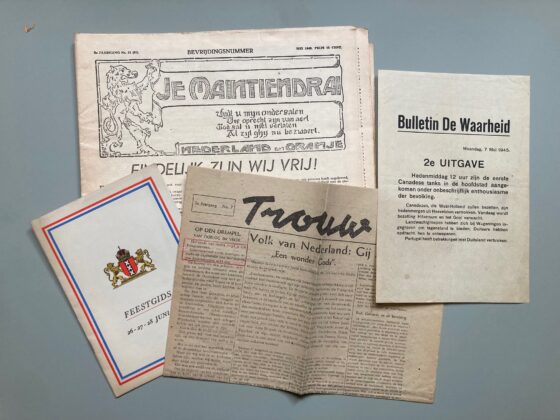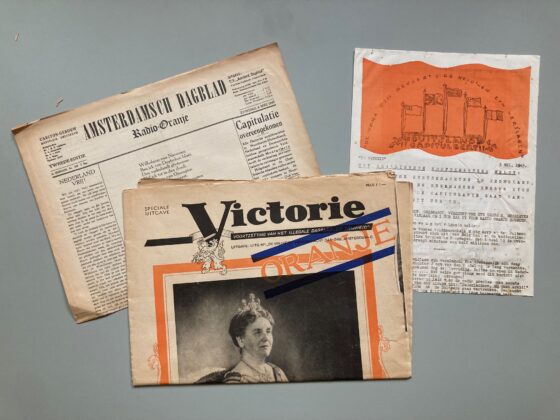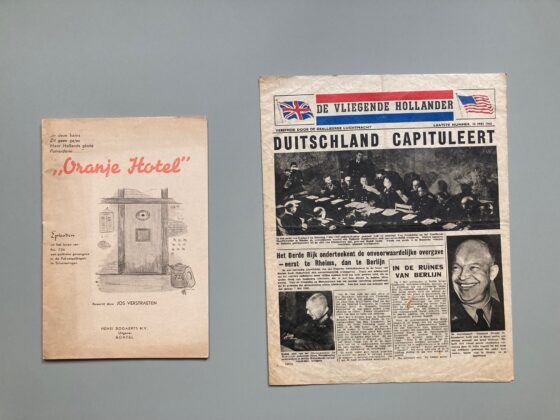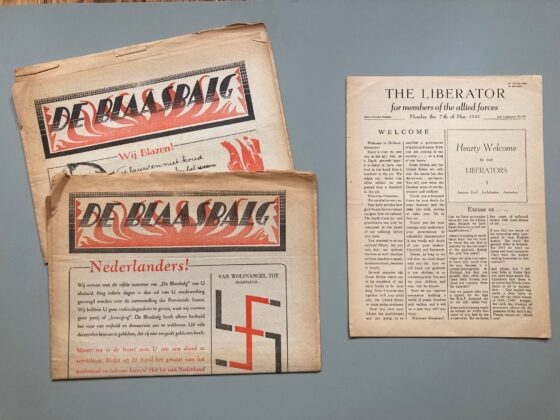How an old archive cabinet revealed a hoard of WWII newspapers

 Newpapers and other documents which had been hidden in an old archive cupboard paint a vivid picture of the end of World War II in the Netherlands. Finder Robin Pascoe has been browsing through its contents.
Newpapers and other documents which had been hidden in an old archive cupboard paint a vivid picture of the end of World War II in the Netherlands. Finder Robin Pascoe has been browsing through its contents.
The archive cabinet in the second hand shop round the corner was just what I was looking for. It had been made perhaps in the 1930s with wooden roll-down doors, but was in bad shape. The keys were missing, the doors were stuck and broken in places, but I decided to take a gamble and bought it.
My part of Amsterdam has a bit of everything and that includes a furniture restoration place run by two young women who are a whizz at doing exactly what you want. I left the cupboard with them. They were so busy that it would take several months, they said, but they would let me know when I could come and get it.
When that day came, I’d almost forgotten what the cupboard looked like. But when I picked it up, it was perfect, with new locks, gleaming wood and dozens of flat shelves just waiting to be filled.
But there was more. Tucked in a hidden compartment at the bottom of the shelving, the restorers had found a cardboard file full of newspapers, leaflets and hand-printed papers – most of which dated from around May 5, 1945, when the Netherlands was liberated from the Nazis.
Messages
It is a fascinating and unexpected haul. The papers and documents are yellow with age, some printed on a Gestetner stencil machine, and the language is a little hard to understand, but they are full of gems about those days of hope over 80 years ago.

‘On the cusp of war and peace’ is the headline in an editorial in Trouw, dated May 5, 1945. ‘The end of our battle is a reality. Yesterday evening, the radio announced the capitulation, from this morning 8am. And even though the Canadians did not arrive in the morning and afternoon as we waited, and the Germans were still walking around with their loaded guns, there was freedom.’
‘This afternoon at 12 o’clock, the first Canadian tanks came into the capital to the indescribable enthusiasm of the population,’ is the opening sentence on a one A5 page ‘second edition’ of De Waarheid, dated May 7, 1945.
A later edition of the paper, from May 9, writes about the first English cigarettes to arrive. It also reports on the arrest of Dutch Nazi chief Anton Mussert who was, apparently, eating strawberries when he was picked up. ‘He asked if he could first finish them,’ the paper said. ‘Then he handed over an attractive etui with the inscription “Von Hitler aan meinen Freund Mussert”. It contained a revolver.’
Allies
In among this pile of wartime souvenirs was an A4 printed sheet in English called The Liberator, which had been put together for the members of the allied forces.
‘A hearty welcome to our liberators,’ it said, in English. ‘Excuse us… that we have no wooden shoes for you, for a keepsake, because have burnt them up to boil our sugarbeetroots, when it is raining so much these days, but we want to clean the air, that is infected by the bad smell of the Germans during the past five years!
‘When our girls don’t seem to have very much time for you, because it is spring-cleaning-time in Holland, but they are grateful that, while they clean our houses, you clean our country from the enemy!’

The paper included details about church services and the library, and the words of the Dutch national anthem – information which would not be out of place in any ‘expat guide’ today.
It is hard to imagine that someone had been thoughtful enough to put together these English texts in the middle of war. A Canadian friend was quick to send a photograph of the paper back home to her parents, whose own relatives were among the troops to liberate the Netherlands.
For a moment, time stood still.
The owner
I have not been able to find out who owned the cupboard and its secret pile of papers. All the second hand shop can remember is that it came from a house on the Beethovenstraat which was being cleared out after an old couple died.
The children, they said, did not want any of their things. But then, the children did not know about the paper file with the newspapers and other documents.
Kees Ribbens, a senior researcher from the Niod institute for war documentation told me the collection is the sort of thing which many people would have put together as souvenirs in those first heady days of freedom.
‘You can keep a diary or take photos, but then you needed a camera… so collecting and keeping the papers was the work of someone who was aware of the historical significance of the time,’ he told me. ‘And it was probably someone with a job, because you needed money to pay for them. But whether it was a man or a woman, it is impossible to say.’
Nazis
Not all the papers related to the end of the war. One is a satirical Nazi propaganda paper called De Gil (the scream) which dates from 1944.

‘A message from Eisenhouwer to our people’, it says. ‘A liberation army for the Netherlands has been set up, it is a question of weeks or maybe days and … the Abyssynian liberators are coming’.
The racism and fear-mongering, dressed up in a coat of irony, is strangely familiar, given the coded comments of the far right in the Netherlands today.
The second publication is a pre war paper called the Blaasbalg, which was published in 1939, ahead of the April provincial elections.
The paper was, to quote its own front page, ‘set up to warn our people against the dangers of anti-Semitism, national socialism and fascism in all its forms, and to reinforce the value of democratic freedom.’
The Blaasbalg, which only existed for six editions, goes on to urge its readers to vote for democracy. Its call to action is a chilling reminder of what was to come, and a warning which is still relevant to this day, given the far right support at the provincial elections just a few weeks ago.
World War II might have ended 78 years ago, but the messages hidden at the bottom of an old filing cabinet still resonate.
Thank you for donating to DutchNews.nl.
We could not provide the Dutch News service, and keep it free of charge, without the generous support of our readers. Your donations allow us to report on issues you tell us matter, and provide you with a summary of the most important Dutch news each day.
Make a donation